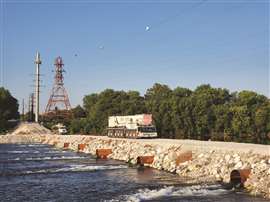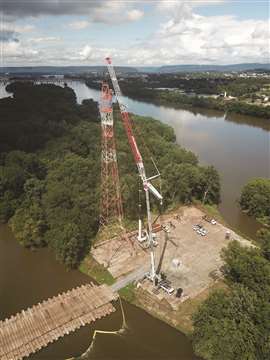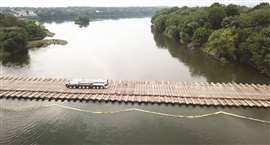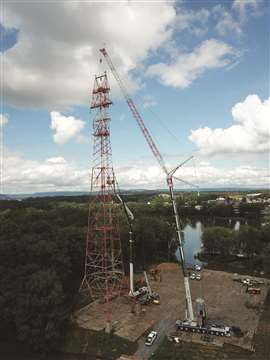Iron Stag Crane tackles transmission tower replacement
01 February 2024
Thomasville, PA-based Iron Stag Crane Service recently supported a powerline transmission tower replacement project. The transmission lines run just south of Harrisburg across the Susquehanna River.
 The tricky part of the job was access to the powerline towers. This was created via a causeway and floating bridge.
The tricky part of the job was access to the powerline towers. This was created via a causeway and floating bridge.
The trickiest aspect of the job was access to the powerline towers, which was created via a 1,700-foot stone causeway from the mainland to the first island which consisted of 30,000 tons of material. An 800-foot floating pontoon bridge was then constructed from the first island to gain access to the second island.
After crossing the causeway, the Iron Stag team set up its Liebherr LTM 1450-8.1 on the first island to erect the new monopole-style transmission tower. When completed, the crane was disassembled and prepped to cross the floating bridge.
A happy medium
Because the pontoon bridge was designed and approved for a 170,000-pound load, the LTM 1450-8.1 was stripped down to 168,000 pounds, according to Jared Marcotte, vice president of Iron Stag Crane Service. After gaining access to the second island, the crane was set up again, and rigged with 184 feet of luffing jib and 295,000 pounds of counterweight.
“The demo of the existing tower presented its standard challenges – estimating weights, planning ideal pick locations and maximizing your time working at heights,” said Marcotte. “Obviously you want to get the tower down as safely, and as quickly as possible.”
Marcotte said that it’s all about finding the “happy medium” between taking too small of a pick and creating extra cutting and rigging time, or taking too large of a pick, increasing the crane size required and allowing for a greater margin of error when estimating the tower section weight.
 After crossing the causeway, the Iron Stag team set up its Liebherr LTM 1450-8.1 on the first island to erect the new monopole-style transmission tower. When completed, the crane was disassembled and prepped to cross the floating bridge.
After crossing the causeway, the Iron Stag team set up its Liebherr LTM 1450-8.1 on the first island to erect the new monopole-style transmission tower. When completed, the crane was disassembled and prepped to cross the floating bridge.
“I.B. Abel, the electrical contractor that hired Iron Stag, did an excellent job of estimating the weights and rigging the tower sections in a safe manner while working with our operator to determine ideal pick locations,” Marcotte said. “Also making sure that when the tower section was cut, the section being lifted and the remaining tower still had structural integrity that allowed the project to continue safely.”
Once the old tower was demolished, Iron Stag’s team stacked the new monopole-style tower, disassembled the crane and crossed back over the bridge.
“This project was nothing short of complex,” said Nick Cummins, project superintendent for I.B. Abel. “Crews had to navigate crossing the Susquehanna River, two Amtrak railroads – including their transmission, catenary and signal lines – as well as crossing Norfolk Southern Railways on both sides of the river, and complying within their stringent guidelines.”
Go with the flow
The 1.2-mile transmission line rebuild project involved building a 1,700-foot-long causeway to gain access to Stucker Island and an 800-foot floating pontoon bridge to gain access to Hess Island.
Yak Access’ Kathy Hopper said the floating road was designed to hold a 170,000-pound crane. The finished floating roadway was 80 feet wide and 525 feet long, and it was built on top of 12 feet of flowing water.
“The biggest challenge was the flow of the river was 6 cubic feet per minute, making anchoring the mats difficult in order to withstand this [flow],” she said.
Marcotte said his team was impressed with the bridges’ performance under such demanding conditions. The job also required the removal of 18 spans of dual circuit 69kV lines, six steel monopoles, 10 wood poles and three lattice towers. One tower was over 315 feet tall.
I.B. Abel’s team installed a dual circuit of four spans of 795 ACSS, 12 spans of 556 ACSR and 18 spans of 0.791 OPGW. They also installed nine new foundation steel monopole structures. The top of concrete reveal heights reached 22 feet and poles reached 230 feet. The three existing river tower demos reached 150 feet and 315 feet. As well, a load break air brake switch was removed and replaced.
Cummins said the particular challenges of the job included the two Norfolk Southern Railroad Crossings. There are two tracks on the east shore and two on the west shore. There is also an Amtrak Crossing with two tracks on the east shore.
 The 1.2-mile transmission line rebuild project involved building a 1,700-foot-long causeway to gain access to Stucker Island and an 800-foot floating pontoon bridge to gain access to Hess Island.
The 1.2-mile transmission line rebuild project involved building a 1,700-foot-long causeway to gain access to Stucker Island and an 800-foot floating pontoon bridge to gain access to Hess Island.
“Setting poles and demolishing the existing steel lattice towers near the railroad tracks was complicated, as was taking down the 315-foot lattice tower,” said Cummins.
For the Susquehanna River Crossing, crews installed grouted rock anchors in the bedrock on the river floor for the floating road. River levels had to be monitored for current flow and debris. Because there was a freshwater intake downstream, the worksite had to be kept clean during the floating road install.
Due to crews working at heights and near and on energized conductors, safety measures were always in place.
“Crews worked in extreme weather conditions from heat to cold to pouring rain,” Cummins said. “Amtrak directed that we work day and night shifts.”
 After making it to the second island, the crane was set up again with 184 feet of luffing jib and 295,000 pounds of counterweight.
After making it to the second island, the crane was set up again with 184 feet of luffing jib and 295,000 pounds of counterweight.
The job was started in May 2023 and is scheduled for completion early this year.
Land, air and water
The fleet of equipment used included three aerial lift platforms capable of reaching heights of 336 feet, two bucket trucks, two telehandlers, a National boom truck, an Altec DT80 digger derrick, log trucks, spiral drill rigs, concrete pump trucks, tandem-axle dump trucks and track dumps. Semi-trucks with trailers, various sized excavators and payloaders were also used. A helicopter performed aerial wire work, while barges and other watercraft were required. I.B. Abel’s team developed critical lift plans for setting and demolition, and plans for wire stringing.
“There were daily flight plans for our helicopter and communication with the three surrounding airports,” said Cummins.
And if that wasn’t enough, a dive team performed underwater drilling to install the grouted rock anchors.
“As the general contractor for the project, I.B. Abel is grateful for the opportunity to showcase our core values and capabilities,” Cummins said. “We worked proudly alongside high-quality subcontractors and tradespeople. We are grateful for the support we received on this project and are looking forward to teaming up with this customer on many projects in the future.”
Iron Stag was excited to be a part of such an interesting and challenging project.
“This project allowed us to show off our capable employees and equipment,” Marcotte said.
STAY CONNECTED


Receive the information you need when you need it through our world-leading magazines, newsletters and daily briefings.




